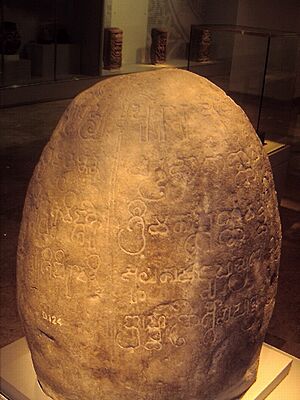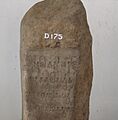Sanskrit inscriptions in the Malay world facts for kids
Have you ever wondered how people in ancient times wrote down important messages or stories? They often carved them into stone or metal! These carvings are called inscriptions. In countries like Malaysia and Indonesia, many old inscriptions have been found. They are mostly written in a very old language called Sanskrit. In Indonesia, these special stone writings are known as Prasasti.
These ancient writings show us that people in Southeast Asia were very interested in ideas and knowledge from India a long, long time ago. They learned to write in Sanskrit, which was a sacred language. This doesn't mean many people from India moved to Southeast Asia. Instead, it shows that the people of Southeast Asia themselves were keen to learn and use these languages and ideas.
Contents
Famous Stone Writings
The Kutai Inscriptions
The oldest known inscriptions in Indonesia are called the Kutai inscriptions. They are also known as the Muarakaman inscriptions. These writings are carved onto seven stone pillars, which are called yupa (meaning "sacrificial posts"). They were found in the eastern part of Borneo, in a place called Kutai, in East Kalimantan province.
These inscriptions are written in an old writing style called the Pallava script and in the Sanskrit language. They tell us about special ceremonies held by a king named Mulavarman. Experts believe these inscriptions were made around the late 300s AD. They show that an early kingdom, influenced by Indian culture, existed in Indonesia even before 400 AD. This makes the Old Kutai Kingdom the very first known kingdom in Indonesia to be shaped by Indian ideas.
The inscriptions mention King Mulavarman, his father Asvavarman, and his grandfather Kundungga. It's thought that Kundungga's name is not Sanskrit, but from the local language. His son, Asvavarman, was the first in the family to have a Sanskrit name. This suggests that Asvavarman was likely the first in their family to follow the Hindu religion.
The Tugu Inscription
The Tugu inscription is another important stone writing found in North Jakarta, Indonesia. It's one of several inscriptions linked to an ancient kingdom called Tarumanagara. This inscription tells us about big water projects. It describes how a leader named Rajadirajaguru ordered the digging of irrigation and drainage canals for the Chandrabhaga river.
It also mentions King Purnawarman and his project to manage the Gomati river in the 22nd year of his rule. These digging projects helped to make the river straighter and wider. This was done to stop floods during the rainy season and to provide water for farming during the dry season.
The Tugu inscription is written in the Pallava script using Sanskrit poetry. It has five lines carved around the stone. Like other inscriptions from the Tarumanagara kingdom, it doesn't have a specific date written on it. However, experts have studied the writing style and believe it was made around the mid-400s AD. The writing on the Tugu inscription looks very similar to another inscription called the Cidanghyang inscription. This makes some people think the same person wrote both of them.
The Tugu inscription is the longest writing from the Tarumanagara kingdom that was ordered by King Purnawarman. It was made to celebrate finishing the canals for the Gomati and Candrabhaga rivers. On the inscription, there's a picture of a staff with a Trisula (a three-pronged spear) on top. This symbol marks the start and end of each sentence.
The Kedah Inscription
In Kedah, Malaysia, an inscription in Sanskrit was found that dates back to 1086 AD. This inscription was left by Kulothunga Chola I, a king from the Chola empire in the Tamil region of India. This discovery shows that the Chola Empire had trade connections with Malaysia a very long time ago.
The Ligor Inscription
An important inscription was discovered in Southern Thailand, in a place called Nakhon Si Thammarat. It's known as the Ligor inscription. This name comes from what Europeans called the area in the 16th and 17th centuries. It is written in Sanskrit and is dated to 775 AD.
One side of the inscription talks about a great king who belonged to the "Lord of the Mountain" family (śailendravaṁśa). This family is also mentioned in other Sanskrit inscriptions found in Central Java, Indonesia. The other side of the inscription tells us that a king from Srivijaya built several Buddhist temples. Srivijaya was a powerful kingdom whose main city was in modern-day Palembang in South Sumatra province, Indonesia.
The Ligor inscription is also known in Thailand as "Inscription No. 23: Inscription of Wat Sema Mueang." It was found in 1907. This inscription is proof that the Srivijaya kingdom expanded its power into the Malay Peninsula.
Images for kids
See also
- Tamil inscriptions in the Malay world
- Symbolic usage of Sanskrit
- Indianisation
- Sanskritisation
- Indosphere
- Greater India





